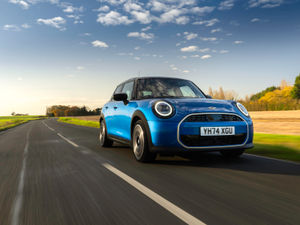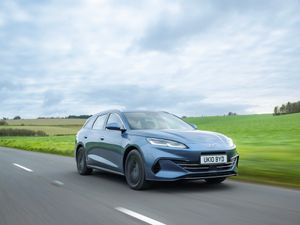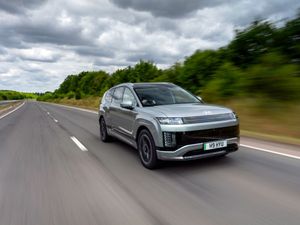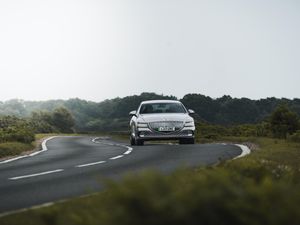Renault Kadjar review: Giving rivals a run for their money
Kadjar . . . it's an unusual name which will make you think. And that's good for Renault because its new model is certainly worth a second look.
For the Kadjar is big brother to the Captur, Renault's first crossover which in three years has become Europe's best-seller in the highly competitive b-segment SUV market.
It is a particularly important car because as Renault's first SUV it has 'captured' most of those sales from rival car makers and boosted the French company's growth to well above the industry average.
The new car is based on the larger Megane platform, as is its close relation the popular Nissan Qashai which ironically will be one of its main rivals.
It has chunky yet aerodynamic styling, the interior space and practicality of an estate car and, on top specification models the option of all wheel drive. Plus it has that high, 'command' driving position which is one reason SUVs now account for 27 per cent of all sales for this size of family car.
While beauty is in the eye of the beholder, the new Kadjar has curvy, contemporary styling with its origins unmistakable thanks to the Renault diamond on the front grille, a feature is shares with the rest of the range.
It's also roomy, with space for five adults (including three six-footers in the back) plus one of the biggest cargo boots in its class,between 472 and 1,478 litres.
But it's clear Renault, as something of a latecomer to the market, is once again out to capture sales from rivals such as the Qashqai and Kuga as prices are very competitive.
There are 18 versions costing from £17,995 to £21,695 which, like for like model is up to £2,000 less than its rivals, and along with a thrifty range of engines will also impact on tax bills for company drivers.
Renault says this is passing on the benefits of cost-savings in production from its use of a common platform and components. Money saved on development, testing, tooling and production can be used to produce a higher spec car at a lower price. And that must be a way to win sales.
When you first get behind the wheel of a Kadjar it conveys the feeling that this is a big car, and a well equipped one too (starting with the utra clear virtual instrument display).
The seats (back as well as front) are soft and sculpted, while the high seating position and large areas of glass – including a 'third row' window in the c-piillar – offer outstanding visibility, Within seconds, you feel this is a nice place to be: it is a 'feel good' car.
There are two diesel options, a 1.6 litre 130Ps version which packs plenty of punch and a 1.5 litre which still performs well on the road but is more economical, capable according to official figures of averaging 74.3mpg with either six-speed manual or automatic gearboxes, with a tax-busting 99g/km of CO2 emissions.
The 130Ps engine clearly has an advantage for acceleration and overtaking but, on two-wheel drive models, still results in an average 65.7mpg and a low 113g/km of CO2.
You do soon appreciate the hefty 320Nm of torque at a low 1,750rpm, which means the 130Ps-equipped Kadjar pulls strongly in every gear for relaxed but satisfying driving.
Balanced against its greater economy, the lower-powered 1.5 litre diesel loses out a little on acceleration, but it still does 0 to 62 in under 12 seconds. Perhaps more relevant to most drivers, it cruises at motorway speeds with a quiet and relaxed demeanour.
If you want the four wheel drive option, this is only available with the higher specification versions and the 130Ps diesel.
There is a three-position selector button – 'auto' for slippery roads when the electronics split the torque between front and rear axles according to conditions, 'lock' which puts the system in full-time four wheel drive if you venture off-road and the third option of front wheel drive only, to save fuel in normal road driving.
The petrol option sounds tiny for a car of this class – just 1.2 litres – but it is Renault's already proven turbocharged power plant, It's been revamped to produce a faster pick-up and response, and with 130PS matches the typical two-litre, normally aspirated petrol engine of just a few years ago.
While the Kadjar is relatively tall, with the advantages of visibility and ease of access, suspension and steering are tuned primarily for road use which make it feel as nimble as a typical saloon or estate rival.
There's no sense that this is an SUV with harsh, long travel suspension, and the electric power steering is progressively weighed so you can turn in with confidence and precision, and without any anticipation of unsettling body roll. The power steering and big wheel arches allow a tight turning circle of well under 11 metres, which combined with the all-round visibility make the Kadjar easy to handle around town.
The car has already been awarded a maximum five stars for safety, and comes with a range of features from six airbags to stability, traction and understeer control systems, hill start assist, ABS and emergency brake assist, and hill start assist,
As you go up and range and price ladder, other features such as parking sensors, lane departure warning, traffic sign recognition, blind spot warning and automatic parking assist systems become available,
Inside, the Kadjar's virtual instrument display are a model of clarity, with all models getting a seven-inch touchscreen display for audio, communications and other functions including navigation, where fitted,
The 190mm ride height does allow four wheel drive Kadjars to venture off hard-surfaces, and 4x4 models also get front and rear skid plates to protect the bodywork.
After its success in the marketplace for smaller crossovers, Renault has plenty of reasons to be confident that Kadjar can do the same against established rivals in what is, to them, a new sector.
A modern, trendy-looking and roomy car with all the attributes that attract such a large number of drivers to the SUV sector is a good place to start, to say nothing of engines offering a good balance of performance and economy, And, of course, that competitive price tag which will have some rivals nervously biting their nails.
And Kadjar? Well, after over a century of car making it must be a) tough to find a name no-one else has used and b) in a global market one which doesn't translate into something terribly embarrasing in another language (yes, we all know one or two of those).
So the official explanation is 'kad' is inspired by quad (something driven by four wheels or legs) and 'jar' from the French word jaillir which means to emerge quickly. Hence a word for an agile four wheel drive vehicle . . .
By John Griffiths





